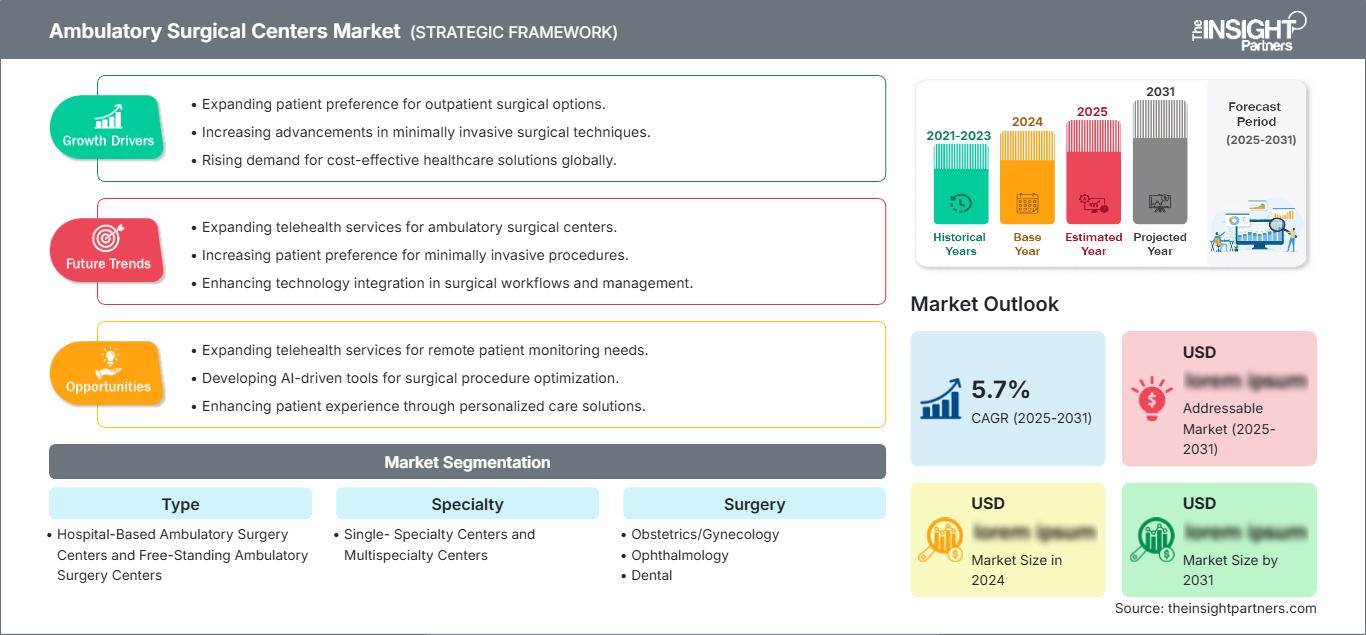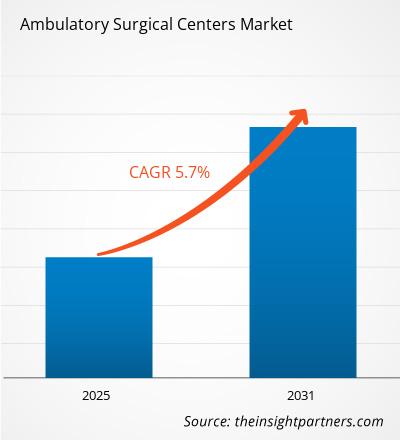The Ambulatory Surgical Centres Market size is expected to reach US$ 155.41 billion by 2031. The market is anticipated to register a CAGR of 6.0% during 2025-2031.
The report is segmented By Type (Hospital-Based Ambulatory Surgery Centers and Free-Standing Ambulatory Surgery Centers), Specialty (Single- Specialty Centers and Multispecialty Centers), Surgery (Obstetrics/Gynecology, Ophthalmology, Dental, Otolaryngology, Endoscopy, Orthopedic, and Others). The global analysis is further broken-down at regional level and major countries. The Report Offers the Value in USD for the above analysis and segments.
Purpose of the Report
The report Ambulatory Surgical Centers Market by The Insight Partners aims to describe the present landscape and future growth, top driving factors, challenges, and opportunities. This will provide insights to various business stakeholders, such as:
- Technology Providers/Manufacturers: To understand the evolving market dynamics and know the potential growth opportunities, enabling them to make informed strategic decisions.
- Investors: To conduct a comprehensive trend analysis regarding the market growth rate, market financial projections, and opportunities that exist across the value chain.
- Regulatory bodies: To regulate policies and police activities in the market with the aim of minimizing abuse, preserving investor trust and confidence, and upholding the integrity and stability of the market.
Ambulatory Surgical Centers Market Segmentation Type
- Hospital-Based Ambulatory Surgery Centers and Free-Standing Ambulatory Surgery Centers
Specialty
- Single- Specialty Centers and Multispecialty Centers
Surgery
- Obstetrics/Gynecology
- Ophthalmology
- Dental
- Otolaryngology
- Endoscopy
- Orthopedic
- Others
Geography
- North America
- Europe
- Asia-Pacific
- South and Central America
- Middle East and Africa
You will get customization on any report - free of charge - including parts of this report, or country-level analysis, Excel Data pack, as well as avail great offers and discounts for start-ups & universities
Ambulatory Surgical Centers Market: Strategic Insights

-
Get Top Key Market Trends of this report.This FREE sample will include data analysis, ranging from market trends to estimates and forecasts.
Ambulatory Surgical Centers Market Growth Drivers
- Shift to Outpatient Procedures: It is well documented that more and more surgeries are longer being performed solely in hospitals but in surgery centers. This is because ASCs are more structured and organized whereby patients are able to go for surgeries and go back home the same day which is quite convenient. The trend toward performing more and more of such surgeries in ASCs is one of the factors contributing to the expansion of the overall market.
- Cost Reduction in Healthcare: Patients as well as providers are adopting ASCs due to high cost containment necessity. Such centers have lower running costs in general than hospitals which leads to more affordable prices for the patients. This cost of treatment collective benefit is good for both health care system and patients.
- Reimbursement Policies: Better payment for outpatient surgical services is increasing the attractiveness of ASCs. As more and more insurance companies are paying for procedures carried out in ASCs, more patients will opt for these facilities to undergo surgery.
Ambulatory Surgical Centers Market Future Trends
- Increase in Surgical Procedures: Projections indicate that there will be an increase of about 25% in the doubtful growth in the number of surgical procedures carried out at ASCs in the next decade. This suggests that more complex surgical procedures will be conducted outpatient in ASCs than has been the case previously.
- Technological Advancements: Advanced surgical care centers (ASCs) are able to expand their skills and capabilities due to new technologies such as minimally invasive surgical procedures and telehealth. These technologies enhance the results for the patients and also reduce the time used to perform the tasks hence making the ASCs more productive.
- Demographic Shifts: Demand for outpatient based surgery services has increased due to the growth of the aged population and chronic diseases. ASCs have also been so positioned to take advantage of this providing the required surgical services in an out patient set up.
Ambulatory Surgical Centers Market Opportunities
- Patient Preference for Outpatient Care: Patients increasingly favor outpatient treatment because of its convenience, faster healing, and lower rates of hospitalization associated with outpatient surgical centers (OSCs). This is also projected to continue in the near future thus increasing the market size further.
- Expansion of Services: Therefore, ASC facilities also tend to broaden their scope of services and add more surgical specialties in order to increase the number of people served and enhance the revenue bases.
The regional trends and factors influencing the Ambulatory Surgical Centers Market throughout the forecast period have been thoroughly explained by the analysts at The Insight Partners. This section also discusses Ambulatory Surgical Centers Market segments and geography across North America, Europe, Asia Pacific, Middle East and Africa, and South and Central America.
Ambulatory Surgical Centers Market Report Scope
| Report Attribute | Details |
|---|---|
| Market size in 2024 | US$ XX Billion |
| Market Size by 2031 | US$ 155.41 billion |
| Global CAGR (2025 - 2031) | 6.0% |
| Historical Data | 2021-2023 |
| Forecast period | 2025-2031 |
| Segments Covered |
By Type
|
| Regions and Countries Covered |
North America
|
| Market leaders and key company profiles |
|
Ambulatory Surgical Centers Market Players Density: Understanding Its Impact on Business Dynamics
The Ambulatory Surgical Centers Market is growing rapidly, driven by increasing end-user demand due to factors such as evolving consumer preferences, technological advancements, and greater awareness of the product's benefits. As demand rises, businesses are expanding their offerings, innovating to meet consumer needs, and capitalizing on emerging trends, which further fuels market growth.

- Get the Ambulatory Surgical Centers Market top key players overview
Key Selling Points
- Comprehensive Coverage: The report comprehensively covers the analysis of products, services, types, and end users of the Ambulatory Surgical Centers Market, providing a holistic landscape.
- Expert Analysis: The report is compiled based on the in-depth understanding of industry experts and analysts.
- Up-to-date Information: The report assures business relevance due to its coverage of recent information and data trends.
- Customization Options: This report can be customized to cater to specific client requirements and suit the business strategies aptly.
The research report on the Ambulatory Surgical Centers Market can, therefore, help spearhead the trail of decoding and understanding the industry scenario and growth prospects. Although there can be a few valid concerns, the overall benefits of this report tend to outweigh the disadvantages.
Frequently Asked Questions
Who are the prominent players in Ambulatory Surgical Centers Market ?
At what CAGR the Ambulatory Surgical Centers Market is projected to grow?
Major driver boosting the Ambulatory Surgical Centers Market market growth?
Which is the fastest growing region in Ambulatory Surgical Centers Market ?
Which region accounts for highest revenue share Ambulatory Surgical Centers Market ?
What years does this Ambulatory Surgical Centers Market cover?
- Historical Analysis (2 Years), Base Year, Forecast (7 Years) with CAGR
- PEST and SWOT Analysis
- Market Size Value / Volume - Global, Regional, Country
- Industry and Competitive Landscape
- Excel Dataset
Recent Reports
Related Reports
Testimonials
Reason to Buy
- Informed Decision-Making
- Understanding Market Dynamics
- Competitive Analysis
- Identifying Emerging Markets
- Customer Insights
- Market Forecasts
- Risk Mitigation
- Boosting Operational Efficiency
- Strategic Planning
- Investment Justification
- Tracking Industry Innovations
- Aligning with Regulatory Trends





















 Get Free Sample For
Get Free Sample For